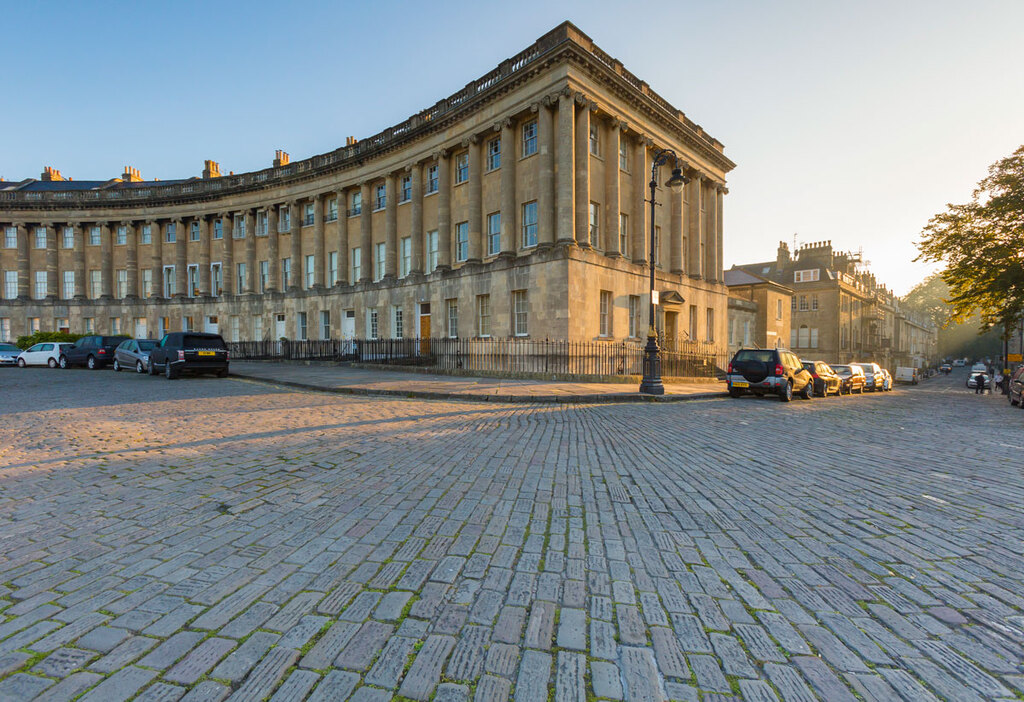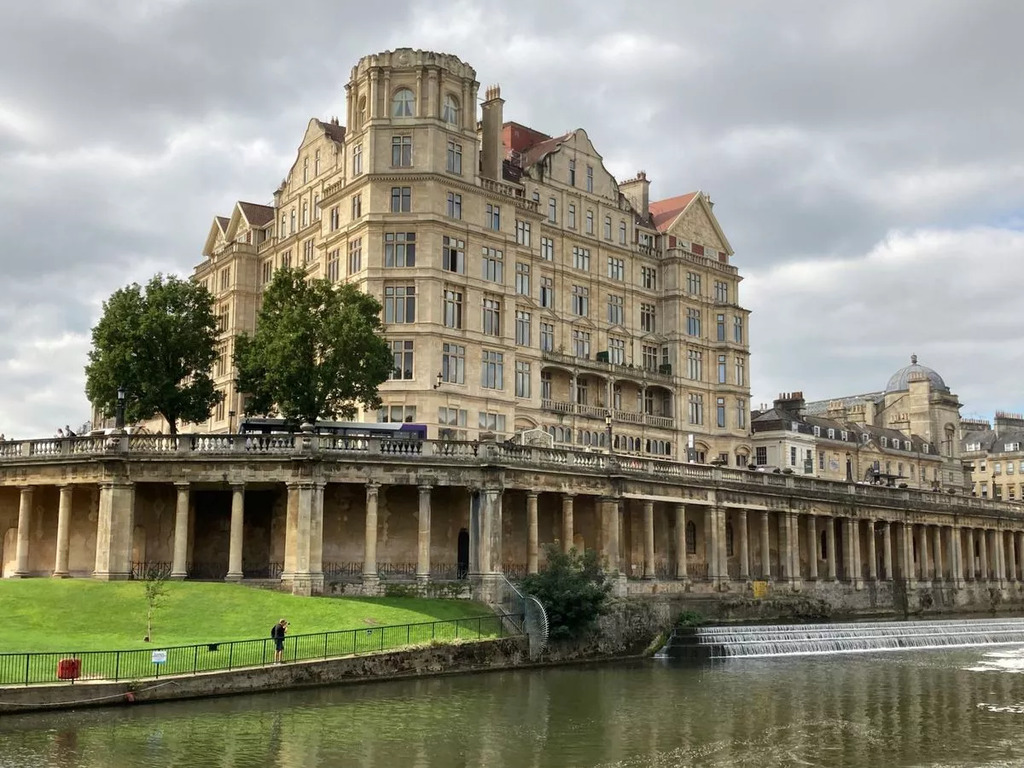Explore this post with:
Nestled in the heart of Somerset, the city of Bath is renowned for its exquisite architecture and rich history. Recognized as a UNESCO World Heritage Site, Bath’s architectural splendour attracts visitors from around the globe. This article delves into some of the city’s most iconic structures and the captivating stories behind their design. From The Royal Crescent’s grandeur and the Empire Hotel’s Victorian elegance to the Theatre Royal’s historical charm and the contemporary luxury of No 15 Hotel, Bath’s buildings offer a fascinating journey through time and style.
1. The Royal Crescent

Historical Background
The Royal Crescent stands as a testament to the elegance and symmetry of Georgian architecture. Completed in 1774, this sweeping Crescent of 30 terraced houses was designed by John Wood the Younger, who sought to create a residential quarter that epitomized the grace and order of the period. The construction utilized the locally quarried Bathstone, giving the Crescent its distinctive honey-coloured appearance. Over the centuries, the Royal Crescent has been home to many notable figures, adding layers of history to its architectural significance.
Architectural Features
The Royal Crescent is a masterpiece of Palladian architecture, characterized by its grand, uniform façade. The 500-foot-long Crescent is adorned with 114 Ionic columns, each three storeys high, which create a sense of rhythm and harmony. The central house, No. 16, originally served as the focal point, featuring a more elaborate design to mark its importance. The use of symmetrical proportions and classical details reflects the Palladian ideals of beauty and order.
Interior Design
The interiors of the Royal Crescent houses vary, reflecting the tastes and styles of their successive owners. Initially, these homes featured high ceilings, ornate plasterwork, and grand staircases typical of Georgian design. Over the years, many houses have been restored to preserve their historical integrity while incorporating modern amenities. Notably, the Royal Crescent Hotel & Spa, occupying No. 15 and 16, showcases a blend of period furnishings and contemporary luxury, offering guests a taste of historical grandeur.
2. Empire Hotel, Bath

Historical Background
The Empire Hotel, an iconic Victorian structure, was built in 1901 to accommodate the influx of visitors to Bath. Designed by the architect Major Charles Edward Davis, the hotel was intended to provide the highest standards of comfort and luxury. The building’s grandeur reflects the prosperity and optimism of the Edwardian era, making it a significant landmark in Bath’s architectural heritage.
Architectural Features
The Empire Hotel boasts an imposing façade characterized by its eclectic mix of styles. The building features a blend of Gothic, Tudor, and French Renaissance elements, creating a visually striking and ornate exterior. Its elaborate stonework, large bay windows, and intricate carvings exemplify the opulence of the period. The hotel’s corner towers and steeply pitched roofs add to its majestic appearance, making it a prominent feature on Bath’s skyline.
Interior Design
Inside, the Empire Hotel’s design has evolved to meet modern expectations while preserving its historical charm. The grand entrance hall, with its sweeping staircase and stained-glass windows, evokes the elegance of the early 20th century. Recent refurbishments have aimed to restore original features, such as decorative plaster ceilings and period fireplaces while integrating contemporary design elements. The blend of old and new creates a unique ambience, offering guests a luxurious and historically rich experience.
3. Theatre Royal, Bath

Historical Background
The Theatre Royal in Bath is one of the oldest and most revered theatres in the country. Opened in 1805, the theatre has a storied history, having hosted numerous famous actors and performances. The original design by George Dance the Younger was intended to reflect the grandeur of London’s West End theatres, providing Bath with a cultural landmark that has endured for over two centuries.
Architectural Features
The Theatre Royal’s exterior is a fine example of neoclassical architecture, featuring a symmetrical façade with a central pediment supported by Doric columns. The building’s elegant proportions and classical details reflect the influence of ancient Greek and Roman architecture. The theatre’s interior, with its richly decorated auditorium, gilded plasterwork, and ornate ceiling, adds to the sense of grandeur and opulence.
Interior Design
The interior design of the Theatre Royal has been carefully preserved and restored over the years to maintain its historical charm. The auditorium, with its plush red seating and gold accents, provides an intimate yet grand setting for performances. The theatre also features modern amenities that enhance the visitor experience without detracting from the historic atmosphere. The combination of period details and contemporary comforts makes the Theatre Royal a cherished cultural venue in Bath.
4. No 15 Hotel, Bath

Introduction to No 15 Hotel
No 15 Hotel on Great Pulteney Street is a striking example of how contemporary design can be seamlessly integrated into historic settings. Originally a Georgian townhouse, the building has been transformed into a boutique hotel that offers a unique blend of old and new. The hotel’s design pays homage to its Georgian roots while incorporating innovative and luxurious elements.
Interior Design by Nina from Room
The interior redesign of the No 15 Hotel was spearheaded by Nina Cooley, an Interior designer from the acclaimed Bath-based Interior Design and Architect studio Room. Nina’s vision for the hotel was to create spaces that are both elegant and whimsical, reflecting the eclectic charm of Bath. Key elements of the redesign include bespoke furnishings, curated art collections, and playful touches that surprise and delight guests. Using rich fabrics, bold colours, and intricate details creates a sense of luxury and comfort.
You can view more details about Nina’s project here.
Nina’s approach was to respect the building’s historical features while introducing modern design elements that enhance the guest experience. The result is a series of rooms and public spaces that feel both timeless and contemporary. Each room tells its own story, with unique design elements that reflect the individuality of the hotel’s overall aesthetic. The impact of Nina’s design is evident in the hotel’s rave reviews and its status as a must-visit destination in Bath.
Conclusion
Bath’s architectural and interior designs offer a captivating glimpse into the city’s rich history and cultural heritage. From the Georgian elegance of The Royal Crescent and the Victorian grandeur of the Empire Hotel to the historical charm of the Theatre Royal and the contemporary luxury of No 15 Hotel, these buildings reflect the unique character of Bath. Their design and preservation continue to inspire and attract visitors, making Bath a true gem for architecture and design enthusiasts. A visit to Bath is not just a journey through history but an experience of the timeless beauty and creativity that define this remarkable city.
In Case You Missed It!
About the Author: archistyladmin
At Architecturesstyle, we’re passionate about smart design, beautiful spaces, and practical tips that help you bring great architecture into everyday life. Whether it's modern home ideas, iconic buildings, or expert advice, our team brings fresh and useful content to readers who love architecture as much as we do.




